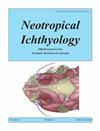墨西哥湾西南部热带海岸入口内鲷鱼的多样性、季节和昼夜分布
IF 2
4区 生物学
Q1 ZOOLOGY
引用次数: 1
摘要
鲷鱼是海洋鱼类,但许多种类的幼鱼迁移到河口,利用这些系统作为育苗区。本研究的目的是了解与拉曼查泻湖入口lutjanids迁移模式有关的主要环境因子。在19个月期间,每月进行24小时周期,每两小时取样一次(442份样本)。考虑了现场记录的环境变量和区域记录,如降雨量、大气温度和日长。利用遗传条形码(COI)验证物种身份。通过PERMANOVA评估显著差异,并使用典型对应分析来确定环境变量的重要性。共记录到6种,其中最丰富的种类在月份间差异显著,迁徙模式主要集中在暖雨季。日长、盐度和降雨量(其中两个与区域发生率有关)是与物种分布显著相关的变量。L. synagris和L. griseus的丰度沿盐度梯度呈分离关系,而Lutjanus analus、L. jocu和L. cyanopterus的丰度与日照长度呈负相关,与降雨量直接相关。因此,迁移模式主要与区域覆盖因子相关,季节性影响较大。本文章由计算机程序翻译,如有差异,请以英文原文为准。
Diversity, seasonal and diel distribution of snappers (Lutjanidae: Perciformes) in a tropical coastal inlet in the southwestern Gulf of Mexico
Abstract Snappers are marine fishes, but juveniles of many species migrate to estuaries, using these systems as nursery areas. The purpose of this study was to know the environmental factors mainly related to the migration patterns of lutjanids in La Mancha lagoon inlet. During 19 months, 24-hour cycles were performed monthly, taking samples every two hours (442 samples). Environmental variables recorded in situ and with regional records such as rainfall, atmospheric temperature and day length were considered. Genetic barcoding (COI) was used to validate species identity. Significant differences were evaluated by PERMANOVA and a Canonical Correspondence Analysis was used to determine the importance of environmental variables. Six species were recorded and the most abundant showed significant differences among months, with migration patterns during the warm-rainy season. Day length, salinity and rainfall (two of them with regional incidence) were the variables significantly associated with the distribution of the species. The abundance of Lutjanus analis, L. jocu, and L. cyanopterus was inversely associated with the length of daylight and directly related to rainfall, while L. synagris and L. griseus showed segregation along a salinity gradient. Thus, migration patterns were mainly correlated with factors of regional coverage and greater seasonal influence.
求助全文
通过发布文献求助,成功后即可免费获取论文全文。
去求助
来源期刊

Neotropical Ichthyology
生物-动物学
CiteScore
2.80
自引率
17.60%
发文量
24
审稿时长
6-12 weeks
期刊介绍:
Neotropical Ichthyology is the official journal of the Sociedade Brasileira de Ictiologia (SBI). It is an international peer-reviewed Open Access periodical that publishes original articles and reviews exclusively on Neotropical freshwater and marine fishes and constitutes an International Forum to disclose and discuss results of original research on the diversity of marine, estuarine and freshwater Neotropical fishes.
-Frequency: Four issues per year published only online since 2020, using the ‘rolling pass’ system, which posts articles online immediately as soon as they are ready for publication. A searchable and citable Digital Object Identifier (DOI) is assigned to each article immediately after online publication, with no need to await the issue’s closing.
-Areas of interest: Biology, Biochemistry and Physiology, Ecology, Ethology, Genetics and Molecular Biology, Systematics.
-Peer review process: The Editor-in-Chief screens each manuscript submitted to Neotropical Ichthyology to verify whether it is within the journal’s scope and policy, presents original research and follows the journal’s guidelines. After passing through the initial screening, articles are assigned to a Section Editor, who then assigns an Associate Editor to start the single blind review process.
 求助内容:
求助内容: 应助结果提醒方式:
应助结果提醒方式:


